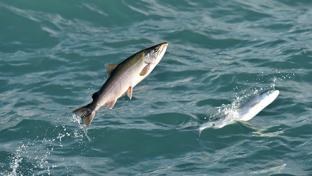What Sustainable Seafood Success Looks Like

From a global perspective, there’s no doubt that farmed seafood has a key role to play in feeding a growing population and helping achieve the United Nations Sustainable Development Goals. Yet here at home, Americans seem to have a love-hate relationship with aquaculture, and lag behind the rest of the world in both production and consumption. It’s striking that per capita seafood consumption in the United States is only 16 pounds per year, compared with a global average of 44 pounds.
Supporting and promoting best practices for aquaculture globally can help ensure that everyone has access to safe, affordable and sustainable seafood. Building a responsible aquaculture industry in the United States can create jobs, support communities, increase efficiencies and reduce reliance on imports.
According to the Food and Agriculture Organization of the United Nations (FAO), global production of wild seafood is expected to remain essentially flat through 2030, growing by less than 1% to reach 91 million metric tons annually. Over that same period, aquaculture production is expected to grow by 37% and reach 109 million metric tons annually. In 2016, aquaculture surpassed wild fish for human consumption, and by 2030, almost 2 of every 3 pounds of seafood consumed by people will come from aquaculture.
Consumer Misconceptions
Americans have very mixed opinions on farmed seafood. According to a 2015 survey conducted by the Global Aquaculture Alliance (GAA) and the Fishin’ Co., almost half of the survey respondents had a negative perception of farmed seafood over concerns about quality, food safety and environmental impacts. Yet only 5% of respondents said they eat only wild seafood.
A more recent study from consultancy Changing Tastes indicates that the gap might not be so big, but also highlighted some consumer misconceptions regarding aquaculture. The survey showed that consumers underestimate how much farmed fish is already eaten. They simultaneously overestimate the amount of production currently coming from open-ocean farming, which they perceive as higher in quality, healthier, better for the environment and more humane than other forms of aquaculture.
This consumer underestimation of the current role of aquaculture is confirmed by the numbers. According to the National Fisheries Institute’s top 10 list for seafood consumption in the United States, six of the top 10 are mostly or fully produced by aquaculture, including the top two items, shrimp and salmon.
Concerns over the environmental impacts of aquaculture and antibiotic use aren’t entirely unfounded. Poorly regulated or even illegal aquaculture development has harmed mangroves, disrupted communities and polluted waterways. While certification of aquaculture products has expanded greatly over the past decade, by the Sustainable Fisheries Partnership’s (SFP) estimates, less than 10% of global production is certified at the farm level by any of the major international standards (Aquaculture Stewardship Council, Best Aquaculture Practices or Global G.A.P.).
At the same time, these concerns are being overly magnified to the point where past mistakes and a few bad apples are spoiling the bunch. Many nongovernmental organizations and even fisher associations are decidedly anti-aquaculture, and use bad examples to unfairly condemn the entire global industry. While some conservation groups have begun to recognize the important role that aquaculture can play in feeding a hungry planet and addressing climate change, others remain steadfastly opposed to aquaculture imports and developing aquaculture in the United States.
Untapped Potential
According to the FAO, North America accounts for less than 1% of global aquaculture production. This represents a huge untapped potential, and a chance to build aquaculture right from the start. Stronger America Through Seafood is one group of companies that have joined forces as to promote domestic aquaculture development.
Whether at home or abroad, retailers and seafood buyers have an important role to play in improving aquaculture practices through aquaculture improvement projects (AIPs), highlighting aquaculture’s benefits and challenging its bad reputation. In wild fisheries, “big buyers” have used their market leverage to drive improvements globally through fishery improvement projects and certification. This same approach has yet to take hold in aquaculture, where many buyers are currently focused on farm-level certification by one of the standards mentioned above. While this can address certain issues, it falls short on delivering the comprehensive industry management needed to improve consumer perception and sustainability, and fails to take a comprehensive approach to effective management.
SFP is working with companies like High Liner Foods, Nestlé, SeaFresh and Beaver Street Fisheries to support improvements through our Asian Farmed Shrimp, Aquaculture and Asian Reduction Fisheries Supply Chain Roundtables, but much more engagement is needed.
In 2018 SFP, Conservation International and the University of California Santa Barbara published guidance on best practices for aquaculture management, focusing on spatial planning (to make sure that aquaculture fits in with other resource users), water quality and carrying capacity (to make sure that all users have access to enough clean water), and coordinated disease management. While the report includes some specific recommendations for Indonesia, the guidance applies to all forms of aquaculture production and is just as relevant for the United States.
Whether domestic or imported, responsible aquaculture is a great way to provide safe, healthy and affordable seafood while supporting jobs and the environment.







